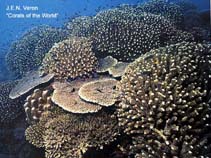Pocillopora grandis Dana, 1846
| Native range | All suitable habitat | Point map | Year 2050 |

|
| This map was computer-generated and has not yet been reviewed. |
| Pocillopora grandis AquaMaps Data sources: GBIF OBIS |
رده بندی / Names اسامي عام | مترادف | CoL | ITIS | WoRMS
Hexacorallia | Scleractinia | Pocilloporidae
Environment: milieu / climate zone / تغييرات عمق / distribution range بوم شناسي
وابسته به آب سنگ; تغييرات عمق 0 - 4800 m (مرجع 100946). Tropical; 36°N - 34°S, 26°E - 77°W (مرجع 847)
Distribution كشورها | مناطق سازمان خوار و بار جهاني (FAO) | Ecosystems | ظهور | معرفي
Indo-Pacific and the Red Sea.
Length at first maturity / Size / Weight / سن
بلوغ: Lm ? range ? - ? cm
توصيف مختصر ريخت شناسي
Life cycle and mating behavior بلوغ | تولید مثل | تخم ریزی | Eggs | Fecundity | Larvae
مآخذ اصلی
مراجع | هماهنگ كننده | همكاران
Veron, J.E.N. 2000 Corals of the world. Volume 2. Australian Institute of Marine Science and CRR Qld. Pty. Ltd. Australia. 429 p. (مرجع 847)
وضعيت در فهرست قرمز IUCN
(مرجع 130435: Version 2025-1)
وضعيت از نظر سايتس (مرجع 108899)
CMS (مرجع 116361)
خطر برای انسان ها
استفاده انسانی
| FishSource |
ابزارها
اطلاعات بيشتر
تركيب غذايي
مصرف غذايي
شکارچیان
Max. ages / sizes
Length-weight rel.
Length-length rel.
نوسانات طولی
Mass conversion
فراواني
منابع اينترنتي
BHL | BOLD Systems | CISTI | DiscoverLife | FAO(Publication : search) | Fishipedia | GenBank (ژنوم, نوکلئوتيد) | GloBI | Gomexsi | Google Books | Google Scholar | Google | PubMed | Tree of Life | Wikipedia (برو, جستجو) | Zoological Record



